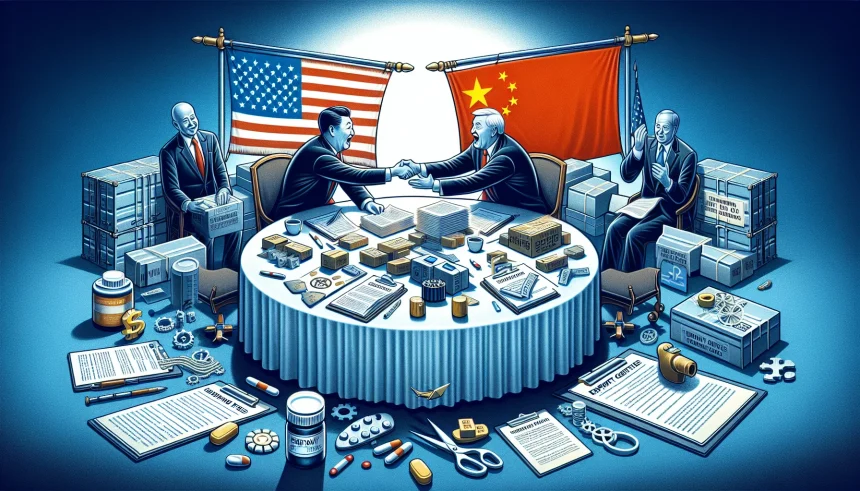Trade envoys for the United States and China signaled a break in years of strain with a joint announcement touching trade, shipping, public health, and technology controls. The negotiators said they reached agreements addressing tariffs, shipping fees, fentanyl, and export controls, aiming to calm markets and reopen channels. The move arrives as both economies face slower growth, supply chain shifts, and political pressure to lower costs at home.
Trade negotiators from China and the U.S. announced that they’d reached agreements on issues spanning tariffs, shipping fees, fentanyl and export controls.
What was announced
The announcement covered four areas that have shaped global commerce and security in recent years. Officials framed the outcome as a bid to reduce friction and improve cooperation where possible. Details remained limited, yet the scope suggests an effort to balance economic interests with public health and security concerns.
- Tariffs: Talks aimed at easing or recalibrating duties set since 2018.
- Shipping fees: Steps to cut costs and increase predictability for ocean freight.
- Fentanyl: Measures to curb chemicals and trafficking routes feeding the opioid crisis.
- Export controls: Guidelines for sensitive technologies and clearer compliance rules.
Background: Years of tariffs and trade strain
The two countries imposed sweeping tariffs during the 2018 trade fight, affecting hundreds of billions of dollars in goods. Many duties remain in place, raising costs for importers and consumers. U.S. farmers, electronics makers, and retailers have pushed for relief, while labor groups warn against sudden rollbacks that could shift jobs overseas.
Shipping costs became a pain point during the pandemic. Container rates soared above $10,000 for some routes at the peak. While prices have eased, disruptions from port backlogs and global tensions keep costs volatile. Clearer fee structures could help small and mid-size exporters plan shipments and improve delivery times.
The fentanyl link: Public health and enforcement
U.S. health officials have tied most overdose deaths to synthetic opioids in recent years. Synthetic opioids were linked to tens of thousands of U.S. deaths last year. Policymakers have urged China to tighten oversight of precursor chemicals and online sales. Public health advocates say cooperation must go further than lab controls and include data sharing and joint investigations.
Law enforcement experts stress that trafficking routes adapt quickly. Any plan will need inspections, audits, and clear penalties. Families of overdose victims say progress should be measured by declines in deaths, not just new rules on paper.
Export controls: Tech, security, and supply chains
Export controls have sharpened after U.S. actions to restrict advanced chips, chipmaking tools, and high-end computing systems. China has issued its own limits on critical minerals. Companies across Asia, Europe, and North America face compliance risks and higher costs. Clearer guidelines could reduce uncertainty for manufacturers while keeping guardrails on sensitive tech.
Tech firms warn that unclear rules slow product timelines and raise compliance bills. Security analysts counter that stronger screening protects key systems and reduces supply chain vulnerabilities. Both sides say predictability is essential.
Industry reaction and the road ahead
Business groups welcomed the announcement. Retailers and port operators expect some relief if shipping fees stabilize. Farm groups hope tariff changes restore market access. Some unions and national security voices urge caution, saying any easing should be tied to verified results on enforcement.
Economists say even modest tariff relief could shave costs for goods such as electronics, furniture, and farm equipment. Lower port fees and fewer delays would help keep prices in check. But the scale of any savings will depend on the fine print, how fast measures take effect, and whether both sides follow through.
What could derail progress
Disputes over compliance and monitoring could stall implementation. Geopolitical flashpoints and election-year politics may add pressure. Companies fear a sudden swing in rules that forces costly changes mid-year.
Analysts recommend a phased approach with public milestones. Transparency on inspections, data sharing, and timelines would build trust. Independent reporting on overdose trends and freight costs could track real-world results.
The announcement signals a step toward calmer trade ties and more predictable rules. The most immediate effects could be felt at ports and in pharmacies, through steadier freight costs and targeted opioid controls. Success will depend on enforcement, clear timelines, and steady communication. Watch for tariff schedules, shipping fee guidance, and joint actions on fentanyl and export screening in the weeks ahead.







